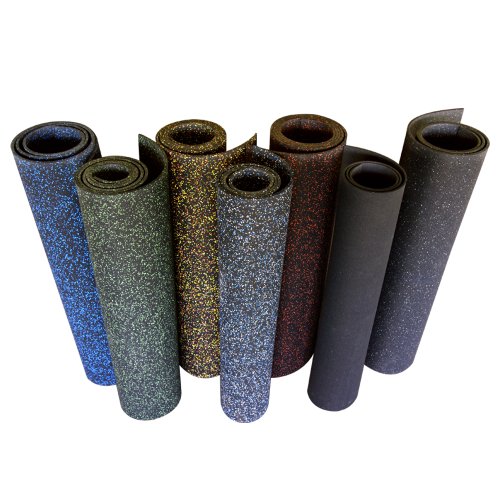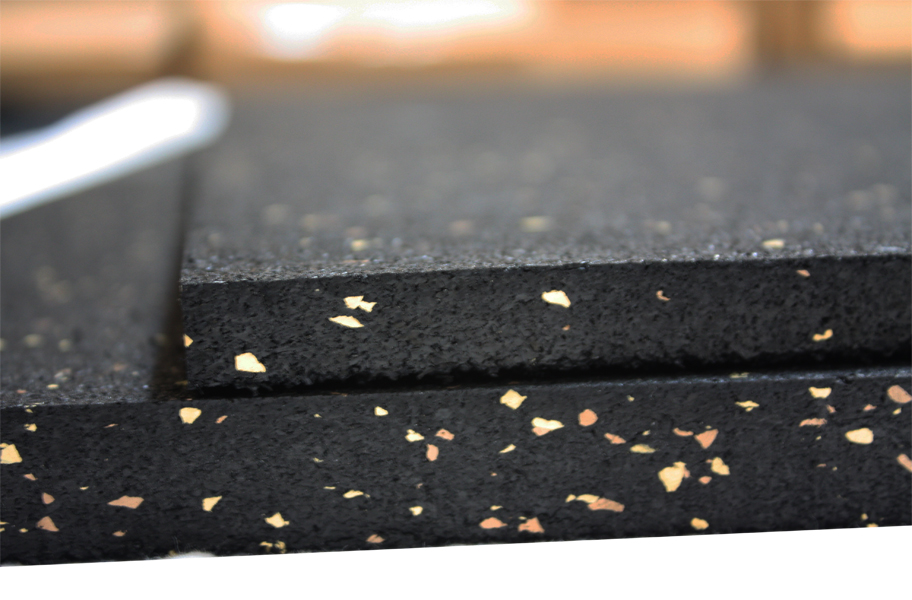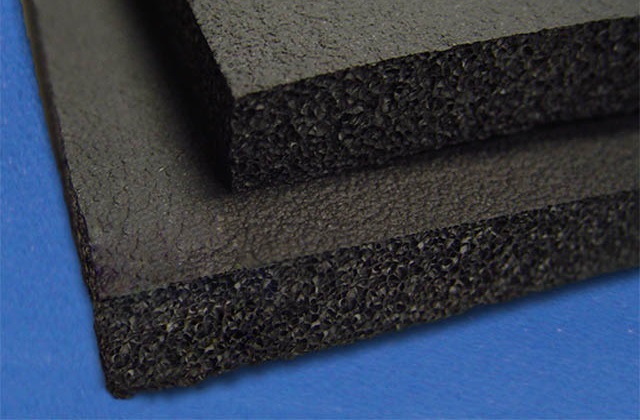Gym floor mats are one of the key building blocks in any sort of commercial or home gym setup. Whether you’ve already got a big assortment of equipment or you’re still trying to choose the right home gym, this is quite literally the foundation for you to build your gym on, so investing in the best gym flooring is an absolute must. Thankfully, gym flooring isn’t too expensive, but there are several different types and materials available so it’s important to choose something that’s high quality and durable so that it lasts you for as many years as possible. The last thing you want is a set of cheap gym mats that are going to rip or get punctured every time you accidentally drop a weight.
With that in mind, I bought samples of the top four highest-rated gym mats so that I could hard-test them myself to see which mats really provided the best foundation. After testing things like quality, durability, ease of installation, and comfort, and then comparing other features and prices, I would definitely say the Rubber Cal Elephant Bark Floor Mat was the best home gym flooring overall. I personally thought the XMark Fitness Ultra-Thick XMat was a higher quality and durability, but not by enough to justify spending twice as much money on (if you’ve got money to blow then by all means, go with this one!).
For those who want to do a little more reading into which brands I tested and how I came to my conclusion, continue reading and I’ll take you through everything start to finish. First, here’s a quick product list so you can see which particular mats I tried out and easily compare the features between each.
Rubber Cal Elephant Bark Floor Mat
• Price: $$
• Material: Rubber
• Thickness: 3/16″
• Dimensions: many different sizes available
• 97% positive user reviews on Amazon
The Rubber Cal Elephant Bark flooring was my #1 choice out of the four mats that I tested. It’s high-quality, extremely durable, and comes at a very affordable price, making this by far the most value for your dollar when it comes to home gym flooring. It’s easy to cut and install and is covered by a generous 3 year warranty.
XMark Fitness Ultra-Thick XMat
• Price: $$$
• Material: Rubber
• Thickness: 1/2″
• Dimensions: 4 x 6 feet
• 94% positive user reviews on Amazon
The XMark Fitness Ultra-Thick XMat was my #2 choice. I actually felt that this gym mat was slightly better than the Rubber Cal Mat, but I couldn’t justify spending twice as much money on it. That being said, the gym-quality half-inch thickness makes the XMat super desirable, and it’s an amazing choice if you don’t mind spending a little more cash.
We Sell Mats Interlocking Floor Tiles
• Price: $
• Material: Foam
• Thickness: 3/8″
• Dimensions: many sizes available
• 95% positive user reviews on Amazon
The We Sell Mats Interlocking Floor Tiles are another highly popular choice for home gym flooring, most notably because they offer 9 different color choices. The mats themselves offer great quality, maximum comfort, and painless installation thanks to their easy interlocking design. Simply fit the pieces together and go.
ProSource Puzzle Exercise Mat
• Price: $
• Material: Foam
• Thickness: 1/2″
• Dimensions: 4 x 6 feet (six 2′ x 2′ tiles)
• 88% positive user reviews on Amazon
The ProSource Puzzle Exercise Mat is one of the best-selling gym floor mats on Amazon. These interlocking gym mats make installation a breeze, making the ProSource mats a great choice for those looking for the absolute easiest setup process. They’re made with a high-quality thick foam that is super comfortable and fairly durable.
TABLE OF CONTENTS
1. Product List
2. Why Use Gym Floor Mats?
3. Types of Home Gym Floor Mats
3.1 Rubber vs. Foam
3.2 Interlocking vs. Square-Cut
4. How I Tested Each Mat
5. Scores For Each Mat By Category
6. Additional Resources: How-To Videos
Why Use Gym Floor Mats?
First off, why should you even use gym floor mats? There are a lot of great benefits to outfitting your home gym with mats, some of which you may already know, and some you may not even realize.
For starters, gym floor mats provide an excellent support system for you to workout on. Thanks to their non-slip surfaces, these mats ensure you have the most stable foundation possible while you exercise. The last thing you want is to slip while you’re holding a heavy weight.
In addition, mats offer a ton of protection. They protect you, your weights, your machines, and especially your floors! Home gym equipment can be damaging to your floors if you don’t lay down a protective foundation to place your equipment on. Think about it. What kind of floors do you have right now? Wood? Concrete? Imagine you accidentally dropped a heavy dumbbell without any mats there. What do you think would be damaged more, the ground, or your dumbbell?
Speaking of which, gym floor mats also offer incredible impact absorption. Let’s use the same example and pretend you do drop that weight. If you’ve got no mats down, the weight is going to hit the ground with a bang and then bounce around and potentially hit other things in your home or maybe even you! Rubber gym flooring prevents that. As soon as a weight hits the ground, it’s pretty much silent and doesn’t bounce but maybe one small inch.
Finally, we all want our home gyms to look truly gym-quality, don’t we? Rubber gym flooring adds that nice extra touch of style that transforms your home gym from amateur to professional, especially if you’ve got a lot of nice home exercise equipment.
Types of Home Gym Floor Mats
Rubber vs. Foam
There are two main materials used for home gym flooring: rubber and foam. While they may look similar, they perform very differently and it’s important to know the differences so that you can pick the best gym flooring for your own personal needs.
Rubber is the most popular choice when it comes to gym mats because it’s a higher quality material and has a much better durability than foam. A home gym is an area that needs to be able to withstand some wear and tear because, as we know, weightlifting and working out can get a little rough sometimes. What I like about rubber it’s the most stable of the two materials. If you ever drop something like a dumbbell or a barbell, the rubber is much better at absorbing impact so the weight won’t bounce around and accidentally hit you. In addition, it’s tear resistant and rarely ever leaves a mark if you do potentially drop something. Rubber gym mats do tend to be slightly more expensive, but as you can see the benefits far outweigh the cost in this case.
Foam is a good cheaper alternative to rubber, but it’s typically a better-fitting material for those that have a small home gym or one that won’t be primarily used for a lot of weight lifting. As I said above, weight lifting can be rough, and foam mats are much more susceptible to tearing if you’re putting it through a lot of heavy use. Foam mat materials have gotten pretty tough nowadays, but they’re still not quite as stable as the rubber is. With that being said, foam mats are generally a great choice for things like yoga studios, stretching areas, martial arts studios, etc. It’s great for bodyweight workouts and other exercises where you’ll be on the mats a lot because it’s got a much softer feel than rubber and is more comfortable to come into contact with.
Interlocking vs. Square-Cut
There are also two main types of mats when it comes to gym floor tiles: interlocking floor mats and square-cut mats. In most cases, interlocking floor mats are made of foam and regular clean-cut mats are made of rubber, and there’s a reason for this. Since foam is much lighter weight and easy to move around, it’s designed to interlock and fit together like puzzle pieces so that once you hook them together, they won’t come loose or separate. Rubber is heavy and a non-slip material so it doesn’t have that problem, so that’s why those are typically clean-cut in squares or rectangles. Once you lay them down, they pretty much never move unless you purposely try to move them again.
I wouldn’t necessarily say one is any better than the other when it comes to interlocking versus square-cut. Both are fine to use and it really comes down to which purposes you’re looking for anyways. As I said above when discussing rubber versus foam, I think rubber is better for regular home gym use and foam is better for lightweight workout areas, so let that be your guide as to which is better for you.
How I Tested Each Mat
I put each gym floor mat through a few different types of tests to see how each mat held up to some typical gym abuse. Further down the page, I’ve listed each specific mat’s score in categories like quality, durability, etc.
Weightlifting
The first activity I tried out on each mat was weight lifting. This is the most common reason people are looking for the best gym flooring so naturally I had to see how well each gym floor mat held up to some good old iron-pumping wear and tear. The main goal here was to see how well each mat held up to heavy use and having weights continuously dropped on them. As expected, this is where the rubber gym mats excelled and the foam mats didn’t do as well. Both the Rubber Cal Elephant Bark Floor Mat and the XMark Fitness Ultra-Thick XMat showed little-to-no sign of wear after several weeks of me pounding on them, whereas the ProSource Puzzle Exercise Mat and the We Sell Mats Interlocking Floor Tiles physically looked a little worn and even showed several indentations from where weights had been dropped. I personally liked the XMark Fitness Ultra-Thick XMat best in this case because its super-tough half-inch thickness offered a lot of impact forgiveness for heavyweight exercises where you’re dropping weights regularly (like deadlifts, CrossFit routines, etc.). What I mean by impact forgiveness is that when you dropped weights on it, the weights did not bounce around at all, and it was relatively quiet when the weights hit the ground (well, as quiet as a loaded up 200 lb barbell can be). The Rubber Cal Elephant Bark Floor Mat did well with impact forgiveness too, I just liked having the XMark’s 1/2″ thickness a little better than the Rubber Cal’s 3/16″ thickness.
One thing in particular that I noticed when lifting heavy was that the foam mats (the ProSource Puzzle Exercise Mat and the We Sell Mats) became somewhat “squishy” when I was lifting anything over 100 lbs (deadlifts, squats, etc.). The foam material isn’t made to handle that much pressure, so when you have a lot of weight loaded up, your feet begin to sink into the mat a little. This causes stability issues and can lead to injury if you lose your balance, so I wouldn’t recommend the foam gym mats if you’re going to be doing a lot of weight lifting in your home gym.
Think about any public gym you’ve ever been to. In the weightlifting area, have you ever seen foam mats? Probably not, because rubber is the far better option when it comes to durability and stability.
Bodyweight Exercises
The second test was to see which mats felt the best when doing bodyweight exercises. Not everyone will be doing primarily weightlifting in their home gym; some people might be looking for the best gym flooring because they want to have an area to do yoga or maybe practice martial arts. The point of this test was to see how comfortable each mat felt since these types of exercises require much more body-contact with the floor mats. To be honest, each mat felt relatively comfortable in this case. I expected the rubber to be uncomfortable just because of its tough nature, but both the Rubber Cal Elephant Bark Floor Mat and the XMark Fitness Ultra-Thick XMat were pleasant enough to reasonably do bodyweight exercises on. Just as with weightlifting, the XMark felt a little nicer because of its ultra-thick padding, but the Rubber Cal was fine nonetheless.
With that being said, the foam mats did have their advantages over the rubber gym mats. The ProSource Puzzle Exercise Mat and the
Interlocking Floor Tiles had a much softer surface which had a far nicer feel to it when the bare skin came into contact with the mats. Although the rubber mats were reasonably comfortable, the squishy nature of the foam mats made bodyweight exercises more appealing on the ProSource and We Sell Mats flooring because it was easier to move around on. Rubber mats have a tendency to provide friction when sliding your body around on them, whereas the soft foam have little-to-no friction drag. This is something to consider as well depending on what type of exercises you’ll be doing most. If you’re going to be doing a lot of exercises where your body comes into contact with the mats often, I’d say any of the four mats I tested were reasonable, but the foam mats were definitely more comfortable.
Scores For Each Mat By Category
Quality
Quality is obviously one of the main concerns when searching for the best gym flooring. You want something that’s well made so that it’s easy to install, looks and feels nice, and doesn’t fall apart after a few months of use. Since I picked the Top 4 highest-rated home gym floor mats to test, there really wasn’t much to say here. Each mat was made with great quality and I was impressed by each brand’s material and construction. If quality is your concern, they were all great choices.
Durability
Durability is probably the #1 top priority when it comes to home gym floor mats. Is the material tough? Is this going to last me for several years? Will it get damaged from equipment? These are all questions I considered when scoring each mat for its durability. In most cases, quality and durability tend to go hand in hand, so if something has good quality it generally has good durability. In this case, we already know each mat was great quality, but since we’re talking about two different materials (rubber vs. foam), there were some noticeable differences in durability. As I mentioned further up the page, rubber is far more durable than foam when it comes to gym floor mats. Rubber is a tougher material by nature and can absorb impact much better, so the rubber gym mats that I tested were better choices when it came to durability. Foam is known to compress over time, becoming less stable and leaving permanent indentations if you have any type of equipment sitting on top of it.
Ease of Installation
Something everyone needs to consider when choosing the best gym flooring is how easy the installation is going to be. Because the foam mats were interlocking tiles, these were the easiest to install. All you had to do was fit them together like puzzle pieces and you were done. They’re lightweight and easy to move around, but that isn’t always a good thing. The rubber mats may have required a little more work on my end, but I actually preferred them over the foam mats for a couple reasons. First, the rubber mats offer a much more stable foundation. They’re heavy, so once you lay them down, they don’t move unless you personally pick them up yourself. This is key for a home gym because you don’t want your gym flooring moving around when you’re exercising. Second, rubber is easier to use for big floor designs and custom floor designs. All you have to do to cut them into custom sizes is take a razor blade to them. The rubber cuts clean and looks professionally done, whereas the foam crumbles and doesn’t look very good. If you’re going for the best DIY installation, rubber is your better choice.
Comfort
The comfort of a gym floor mat is going to be more important to those who will be coming into physical contact with the mats frequently. Because each mat I tested was pretty high-quality, all were reasonably comfortable and didn’t present any serious issues when using them. With that being said, I’d say the foam mats were the best gym flooring when it came to the category of comfort. They had a softer feeling to them, making them the better choice if you’re going to be in contact with the mats a lot.
Additional Resources: How-To Videos
Now that we’ve picked out the best gym flooring for your new home gym, I wanted to include a couple helpful videos to help you get your new flooring all set up. Below, you’ll learn how to lay, cut, and install rubber home gym mats.










